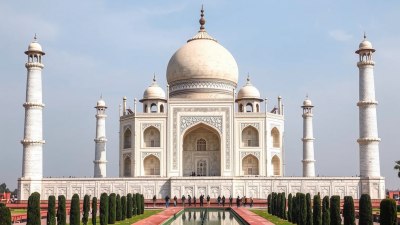The Taj Mahal in India Doesn’t Believe in Eternal Love Anymore
Explore the changing significance of the Taj Mahal as a symbol of eternal love and its evolving perception in modern times.

Image created with Flux Schnell
The Taj Mahal, an epitome of love, art, and architectural brilliance, stands majestically along the banks of the Yamuna River in Agra, India. Built in the mid-17th century by Mughal Emperor Shah Jahan as a mausoleum for his beloved wife Mumtaz Mahal, this UNESCO World Heritage site has long been celebrated as one of the most romantic monuments in the world. Its pristine white marble façade, intricate carvings, and symmetrical gardens attract millions of visitors each year, all eager to witness the grandeur of this legendary structure. However, as time progresses, the narrative surrounding the Taj Mahal is evolving. The notion of the Taj Mahal as a monument epitomizing eternal love is being challenged by modern realities and cultural shifts in perception.
Historically, the Taj Mahal symbolizes an immutable bond between two lovers, immortalized through art and architecture. Its tale of love, loss, and devotion has inspired poets, artists, and romantics alike. But in contemporary times, the concept of love itself is undergoing transformation. With changing societal norms like growing individualism and fluctuating definitions of love, the once unassailable belief in eternal love is being critically examined.
The Historical Context
The construction of the Taj Mahal was a response to an emotional void left by the death of Mumtaz Mahal. It was born out of a profound love that transcended the temporal. Shah Jahan's determination to create a monument that would serve as a lasting symbol of their love is a reminder of how powerful love can shape history. The blend of Persian, Islamic, and Indian architectural styles seen in the Taj Mahal reflects a cultural confluence, capturing the essence of love that knows no boundaries. Yet, as romantic as this tale is, it also oversimplifies the complexities of human relationships. Love is not always eternal; it struggles against various forces, both internal and external.
Modern Interpretations of Love
Today's world presents a vastly different landscape for relationships compared to the era of Shah Jahan. The concept of love has broadened to encompass various forms, including platonic, familial, and self-love. Social media and globalization have transformed how we perceive and engage in romantic relationships. Instant communication and digital interactions redefine the traditional courtship. With these changes come challenges that contribute to the fluctuation of love's permanence. Many couples now navigate relationships in a society that places high value on personal freedom and fulfillment. This radical shift invites scrutiny into the notion of eternal love.
The Influence of Culture and Media
Cultural narratives and media representation play a substantial role in shaping societal beliefs about love. While classic tales of romance often portray eternal love as an ideal, modern storytelling explores the intricacies of relationships—highlighting infidelity, separation, and diverse love dynamics. Movies, songs, and literature increasingly depict love as a complicated journey rather than a final destination. This raises important questions: Can love be eternal in a world that constantly changes? In this new paradigm, the Taj Mahal transforms from a static symbol of eternal love to a reflection of human experience and vulnerability.
The Environmental Impact
Besides cultural shifts, the physical integrity of the Taj Mahal itself faces challenges. Pollution and environmental degradation threaten its marble structure, which requires continuous restoration efforts. The monument symbolizes the enduring nature of love, yet its survival is compromised by contemporary neglect. This irony prompts a deeper reflection—can a symbol of eternal love withstand the test of time if it is not cared for? Just as relationships require nurturing and attention to flourish, so too does the Taj Mahal need preservation to maintain its stature as a beacon of love.
Redefining Eternal Love
In light of these societal and environmental shifts, it is crucial to recognize that the idea of eternal love is not obsolete; rather, it is evolving. Many people still believe in love that endures, but they understand that such love requires effort, sacrifice, and acceptance of imperfection. Acknowledging the transient nature of certain relationships allows for a more authentic and realistic comprehension of love's essence. The Taj Mahal can still inspire us to cherish love deeply, but it also encourages a mindset of adaptability in recognizing that every relationship holds its unique challenges.
The Legacy of the Taj Mahal
While the Taj Mahal may appear to be losing its identity as a monument solely of eternal love, it simultaneously gains complexity and depth as a symbol of human experience. Its walls encapsulate stories of joy, sacrifice, despair, and beauty—themes that resonate across cultures and generations. The knowledge that even the grandest expressions of love are subject to time and change does not diminish their significance but enhances the appreciation for the struggle and triumph within relationships.
The Future of Love and the Taj Mahal
As we look towards the future, the Taj Mahal serves as a mirror reflecting our evolving understanding of love. It embodies not just the triumph of love but also the fragility that comes with it. Love, in its many forms, remains relevant, but it is essential to celebrate it with a recognition of its complexities. The dialogue surrounding the Taj Mahal illustrates that love, just like its architecture, must adapt and evolve in response to the surrounding world.
The Taj Mahal, once an unwavering symbol of eternal love, now embodies a broader spectrum of human experience, encapsulating passion, loss, and resilience. As we navigate the evolving cultural landscape, the lessons from this magnificent monument challenge us to redefine what love represents in our lives. While the sentiment behind Shah Jahan's creation remains powerful, it is essential to embrace a more nuanced interpretation of love—a form that is transient yet meaningful. In this way, the Taj Mahal continues to inspire and engage, evolving its role from a simply romantic monument to a rich canvas representing the ever-changing dynamics of love.











